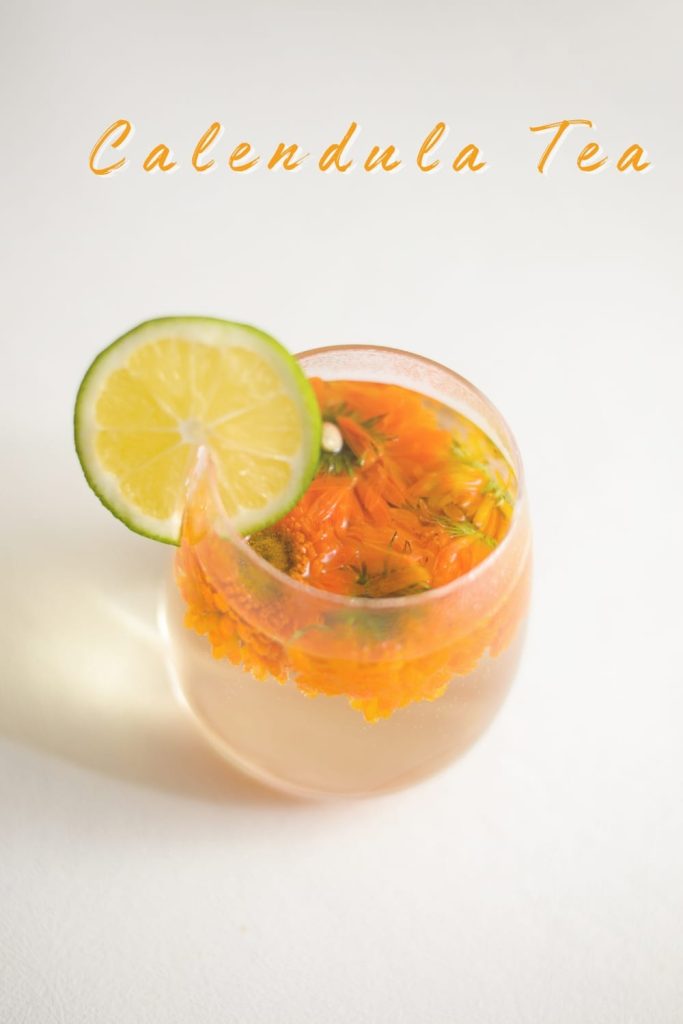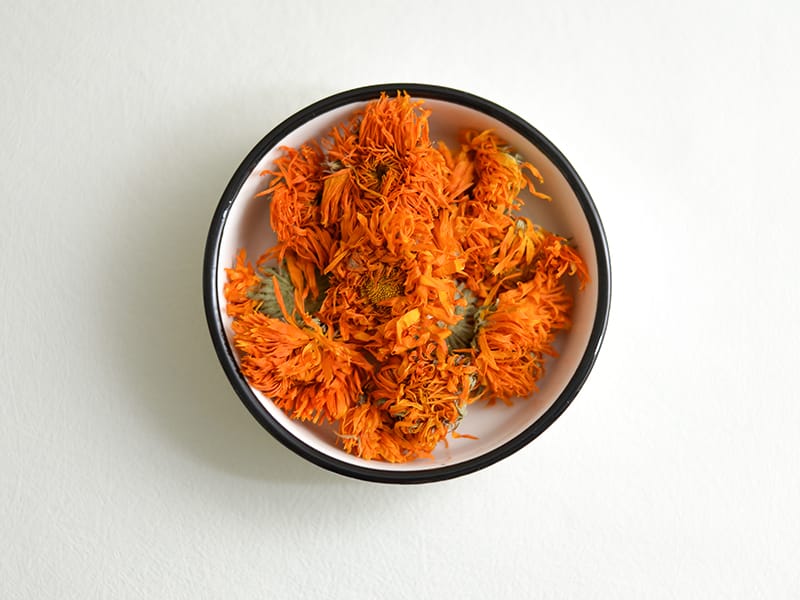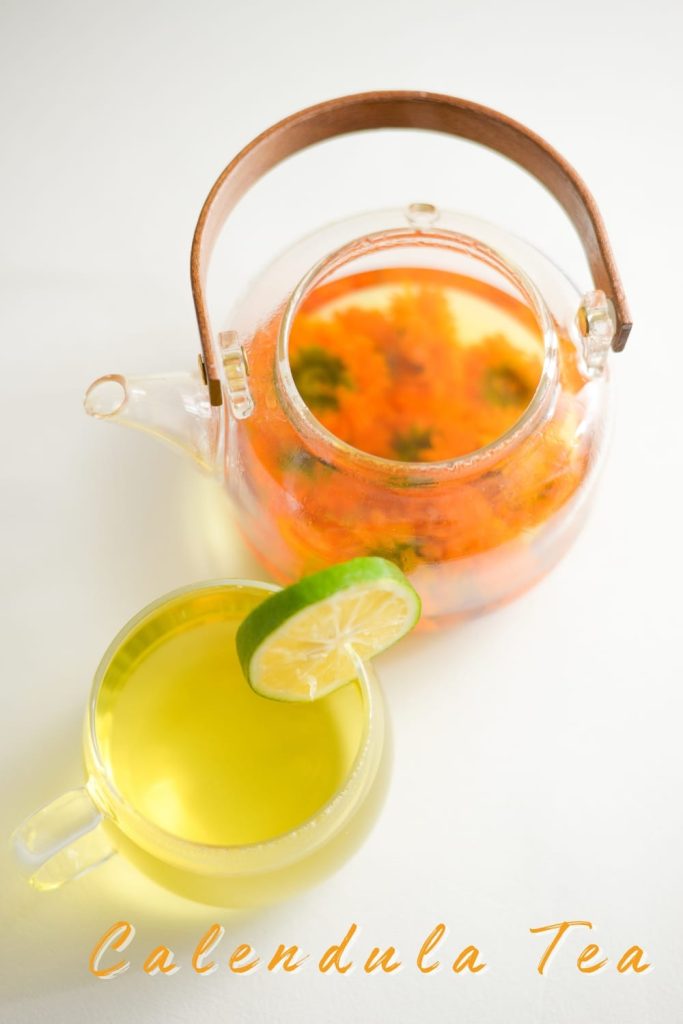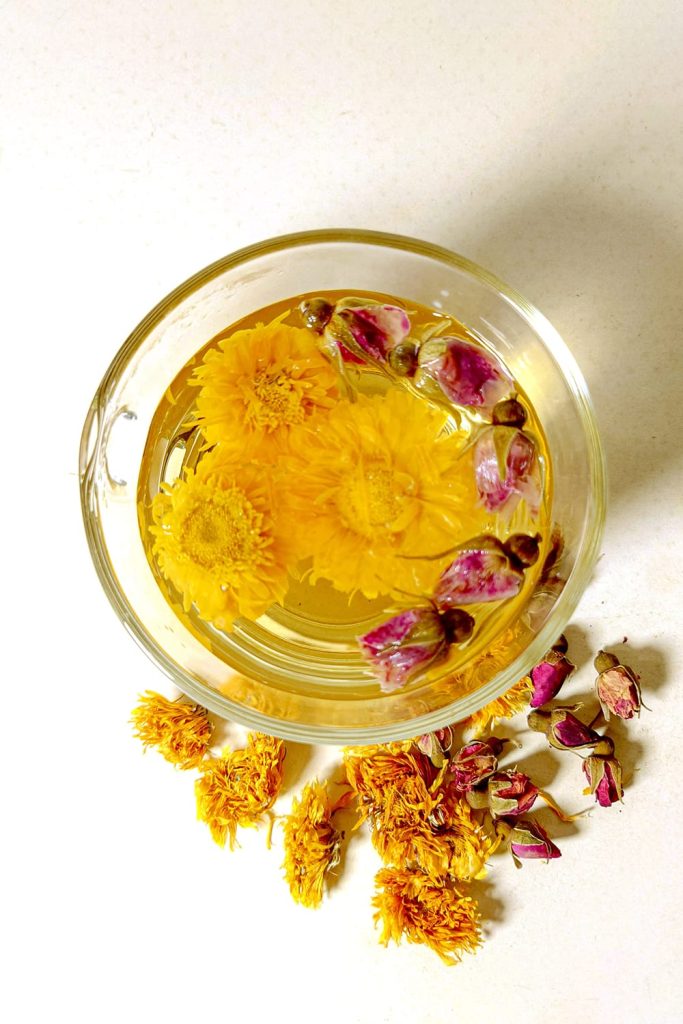Last Updated on 09/18/2023 by Desmond
Calendula tea is a popular herbal tea. Not all because of how rich and significant health benefits it brings or the flavor(actually it tastes so-so,) but the looks it soke in water is very beautiful. It looks like a sun shining gold. However, if you think calendula is just a gaudy drink, you may be wrong.

CONTENT
What Is Calendula
Calendula, most times called Calendula officinalis L., is a herbaceous plant that originated in the Mediterranean region. It was said the name is from the word “calends,” which refers to the first day of a month in ancient Rome because Romans saw that calendulas were always blooming that day.
Just like marigolds, calendula is also in a broad family and is often called a marigold, too. Actually, they are from different genus, and their appearances, tastes, and benefits have a gap. You can find out the differences between Marigold and Calendula here.
People have loved calendula much since the old times. The pretty flower is fantastic for decorating gardens(that makes calendula easily collected) and can be used for dye. The most important is that calendula has a high medical value. In many folk remedies, calendula was often made into creams for treating wounds and some skin diseases. Nowadays, calendula is still a common primary ingredient in skincare products.

Calendula Tea Benefits
Calendula tea is less famous than calendula cream. However, it still is a mild herbal tea trending in folk remedies. In the Middle Ages, medicine was not as advanced as it is now, people often collected calendula flowers, dried them, and then made infusions to cure some common illnesses. Even in a healthy state, having calendula tea can also get some great health benefits.
Antioxidant
Calendula contains many types of powerful antioxidants like triterpenes, flavonoids, polyphenols, and carotenoids. These components can against oxidative stress response and inflammations in the body, and lead to help:
- delaying aging
- reduces the inflammation in the body
- reduces the risk of chronic diseases such as heart disease and Alzheimer’s disease
Solve Digestive Problems
Traditionally, calendula tea was often used for solving digestive problems. Its anti-inflammatory and antibacterial properties can help with curing peptic ulcers. A study showed that calendula tea effectively relieves the esophagus’s inner wall and reduces inflammation, which helps with heartburn and reflux. Besides, some folk remedies also use calendula tea for diarrhea.
Skin Beauty
Calendula cream works more effectively than tea on skin beauty. Even so, calendula tea still lets you get a better skin condition with its antioxidant capacity. In TCM, calendula can balance the “heat” inside the body. If you often eat high-heat fried food or just finished, having a cup of calendula tea may prevent acne, at least not so much worse.
Regulate The Menstrual Cycle
In Italian and Pakistani folk medicines, calendula tea is believed to induce menstruation, regulate the menstrual cycle, and relieve pain. But it needs more study support.
Oral Health
Just like most other natural-antioxidant-contained teas(including true teas and herbal teas,) having calendula tea also helps reduce oral inflammation and helps heal minor oral epidermal lesions. But it doesn’t work well to relieve sore throat. Its antibacterial properties also help keep the mouth healthy and fresh breath.
Relating Reading: Try These 9 Best Herbal Tea For Sore Throat Relieve
Potential Anti-cancer Roles
A study expressed that there are significant cancer-fighting compounds contained in calendula extract, and they are able to be applied to palliative treatment and reduce the pain and side effects of radiotherapy. It has a potential in the new cancer treatment development. Still, a fact you should know clearly is that it doesn’t mean having calendula tea can cure cancer or reduce the risk.

Who Is Not Suggested To Drink Calendula Tea?
Even though calendula tea is certified safe by the FDA, just like most other herbal teas, it still has some potential side effects, and it’s not suitable for everyone. The following groups should avoid to have calendula tea:
- people who is allergic to the Asteraceae family plants(you can smear few tea on your arm for testing first)
- pregnant and breastfeeding women(the menstrual cycle regulate effect may caused by estrogenic)
- people who during a drug therapy(calendula may has interactions with some medications, you should ask your doctor first)
How Does Calendula Tea Taste?
Calendula tea shows a bright golden color, brewing with a glass teapot can better appreciate this beauty. While the infusion first slips into your mouth, it brings a fresh and chrysanthemum-like scent, and you can feel an impalpable vegetal sweetness. Calendula doesn’t contain caffeine like the traditional ture tea, so it won’t astringent your tongue. However, the base note is a bit earthy and bitter. You may need some honey or lime juice to improve the flavor.
The not-good taste becomes more significant by brewing time and rounds grow, finally turning into an unpalatable stink. Thus, you better control the preparation amount well; one brew is enough. You should not brew it with boiling water to avoid overcooking the flowers prematurely and creating a bad taste; the 85℃ water may just be suitable.
Blending Calendula With 5 Other Herbs
The natural herbaceous flavor of calendula tea may not satisfy everyone. Still, you can blend and brew it with other herbs to make it more delicious. Much less, you also won more health benefits from that.

Calendula Rose Tea
Both calendula and rose have a skin-beauty effect on the skin. The intense floral of the rose can neutralize the calendula earthy well and create a more natural flavor.
Ingredients:
- 3 dried calendula flowers
- 5 dried rose buds (culinary-grade)
Instructions:
- Boil water and allow it to cool for a minute or two to around 88°C
- Place the dried calendula and dried rose in a teapot or heatproof cup
- Pour the hot water over the herbs
- Cover and steep for 5-7 minutes for a delicate floral flavor
- Strain the tea into a cup
- Optionally, add 1TSP of honey to enhance the sweetness, or enjoy it as is to savor the natural floral notes
Calendula Ginger Tea
Ginger brings spice and warmth to calendula. This tea is very suitable for those who are stuffed, need good digestion, or want to warm their stomach.
Ingredients:
- 5 dried calendula flowers
- 1TSP dried ginger root (or a small slice of fresh ginger)
Instructions:
- Boil water and let it cool for a minute or two to about 88°C
- Place the dried calendula and dried ginger (or fresh ginger slice) in a teapot or heatproof cup
- Pour the hot water over the herbs
- Cover and steep for 5-7 minutes for a mild ginger flavor or longer for a more decisive ginger kick
- Strain the tea into a cup
- You can add honey or a touch of lemon for extra flavor if desired
Calendula Chamomile Tea
Chamomile is a familiar partner to calendula. These two flowers steeping in the water together show very beautifully. The apple note of chamomile improves the calendula flavor, and the combination of their antioxidant ability brings a better anti-inflammatory effect.
Ingredients:
- 3 dried calendula flowers
- 3 dried chamomile flowers
Instructions:
- Boil water and allow it to cool for a minute or two to around 88°C
- Place the dried calendula and chamomile flowers in a teapot or a heatproof cup
- Pour the hot water over the herbs
- Cover and steep for 5-10 minutes, depending on your preference for strength
- Strain the tea into a cup
- Optionally, add honey or lemon to taste
Calendula Lemon Balm Tea
The refreshing aroma of lemon balm matches calendula perfectly. This is a calming tea that is suitable for you to relax after a busy day.
Ingredients:
- 2 dried calendula flowers
- 1TSP dried lemon balm leaves
Instructions:
- Boil water and allow it to cool for a minute or two to around 88°C
- Place the dried calendula and lemon balm leaves in a teapot or heatproof cup
- Pour the hot water over the herbs
- Cover and steep for 5-7 minutes, depending on your preference
- Strain the tea into a cup
- Optionally, add honey for sweetness or a lemon slice for extra zing
Calendula Lavender Tea
The calendula may be reminiscent of the sun, but it has no refreshing effect. Instead, it blends well with lavender, which represents night, for a restful and relaxing dream.
Ingredients:
- 3 dried calendula flowers
- 1TSP dried lavender flowers
Instructions:
- Boil water and let it cool for a minute or two to approximately 88°C
- Add the dried calendula and lavender flowers to a teapot or heatproof cup
- Pour the hot water over the herbs
- Cover and steep for 5-7 minutes, depending on your taste preferences
- Strain the tea into a cup
- Optionally, sweeten with honey
References
A review on phytochemistry and ethnopharmacological aspects of genus Calendula
Calendula officinalis: Potential Roles in Cancer Treatment and Palliative Care